Chlorination of Antivirals in Wastewater: Effects of Microplastics and Ecotoxicity on Aquatic and Terrestrial Species
Abstract
1. Introduction
2. Materials and Methods
2.1. Synthetic Wastewater
2.2. Measurement of Antivirals
2.3. Chlorination Experiments
2.4. Ecotoxicological Assays
2.4.1. A. fischeri Bioluminescence Inhibition Test
2.4.2. E. crypticus Survival and Reproduction Test
3. Results and Discussion
3.1. Effect of Chlorination on ATVs
3.2. Effect of Chlorination on A. fischeri Bioluminescence
3.3. Effect of Chlorination on E. crypticus Survival and Reproduction
4. Conclusions
Author Contributions
Funding
Data Availability Statement
Acknowledgments
Conflicts of Interest
Abbreviations
| ATVs | Antivirals |
| MPs | Microplastics |
| FAV | Favipiravir |
| OSE | Oseltamivir |
| SW | Synthetic wastewater |
| TP | Transformation product |
| WWTP | Wastewater treatment plant |
| THM | Trihalomethane |
| COD | Chemical oxygen demand |
| DOC | Dissolved organic carbon |
| NH3-N | Ammonia-nitrogen |
| NO2−-N | Nitrite-nitrogen |
| TP | Total phosphorus |
References
- Agrawal, U.; Raju, R.; Udwadia, Z.F. Favipiravir: A New and Emerging Antiviral Option in COVID-19. Med. J. Armed Forces India 2020, 76, 370–376. [Google Scholar] [CrossRef]
- Madelain, V.; Duthey, A.; Mentré, F.; Jacquot, F.; Solas, C.; Lacarelle, B.; Vallvé, A.; Barron, S.; Barrot, L.; Mundweiler, S.; et al. Ribavirin Does Not Potentiate Favipiravir Antiviral Activity against Ebola Virus in Non-Human Primates. Antivir. Res. 2020, 177, 104758. [Google Scholar] [CrossRef] [PubMed]
- Azuma, T.; Ishida, M.; Hisamatsu, K.; Yunoki, A.; Otomo, K.; Kunitou, M.; Shimizu, M.; Hosomaru, K.; Mikata, S.; Mino, Y. Fate of New Three Anti-Influenza Drugs and One Prodrug in the Water Environment. Chemosphere 2017, 169, 550–557. [Google Scholar] [CrossRef] [PubMed]
- Ghosh, G.C.; Nakada, N.; Yamashita, N.; Tanaka, H. Occurrence and Fate of Oseltamivir Carboxylate (Tamiflu) and Amantadine in Sewage Treatment Plants. Chemosphere 2010, 81, 13–17. [Google Scholar] [CrossRef] [PubMed]
- Matsuo, H.; Sakamoto, H.; Arizono, K.; Shinohara, R. Behavior of Pharmaceuticals in Waste Water Treatment Plant in Japan. Bull. Environ. Contam. Toxicol. 2011, 87, 31–35. [Google Scholar] [CrossRef]
- Kuroda, K.; Li, C.; Dhangar, K.; Kumar, M. Predicted Occurrence, Ecotoxicological Risk and Environmentally Acquired Resistance of Antiviral Drugs Associated with COVID-19 in Environmental Waters. Sci. Total Environ. 2021, 776, 145740. [Google Scholar] [CrossRef]
- Muriuki, C.; Kairigo, P.; Home, P.; Ngumba, E.; Raude, J.; Gachanja, A.; Tuhkanen, T. Mass Loading, Distribution, and Removal of Antibiotics and Antiretroviral Drugs in Selected Wastewater Treatment Plants in Kenya. Sci. Total Environ. 2020, 743, 140655. [Google Scholar] [CrossRef]
- Abafe, O.A.; Späth, J.; Fick, J.; Jansson, S.; Buckley, C.; Stark, A.; Pietruschka, B.; Martincigh, B.S. LC-MS/MS Determination of Antiretroviral Drugs in Influents and Effluents from Wastewater Treatment Plants in KwaZulu-Natal, South Africa. Chemosphere 2018, 200, 660–670. [Google Scholar] [CrossRef]
- Nannou, C.; Ofrydopoulou, A.; Evgenidou, E.; Heath, D.; Heath, E.; Lambropoulou, D. Analytical Strategies for the Determination of Antiviral Drugs in the Aquatic Environment. Trends Environ. Anal. Chem. 2019, 24, e00071. [Google Scholar] [CrossRef]
- Race, M.; Ferraro, A.; Galdiero, E.; Guida, M.; Núñez-Delgado, A.; Pirozzi, F.; Siciliano, A.; Fabbricino, M. Current Emerging SARS-CoV-2 Pandemic: Potential Direct/Indirect Negative Impacts of Virus Persistence and Related Therapeutic Drugs on the Aquatic Compartments. Environ. Res. 2020, 188, 109808. [Google Scholar] [CrossRef]
- Giacobbo, A.; Rodrigues, M.A.S.; Zoppas Ferreira, J.; Bernardes, A.M.; de Pinho, M.N. A Critical Review on SARS-CoV-2 Infectivity in Water and Wastewater. What Do We Know? Sci. Total Environ. 2021, 774, 145721. [Google Scholar] [CrossRef] [PubMed]
- Nas, B.; Uyanik, S.; Aygün, A.; Doğan, S.; Erul, G.; Nas, K.B.; Turgut, S.; Cop, M.; Dolu, T. Wastewater reuse in Turkey: From present status to future potential. Water Supply 2020, 20, 73–82. [Google Scholar] [CrossRef]
- Li, B.; Zhang, T. Different Removal Behaviours of Multiple Trace Antibiotics Inmunicipal Wastewater Chlorination. Water Res. 2013, 47, 2970–2982. [Google Scholar] [CrossRef] [PubMed]
- Nam, S.W.; Jo, B.I.; Yoon, Y.; Zoh, K.D. Occurrence and Removal of Selected Micropollutants in a Water Treatment Plant. Chemosphere 2014, 95, 156–165. [Google Scholar] [CrossRef] [PubMed]
- Chen, W.L.; Ling, Y.S.; Lee, D.J.H.; Lin, X.Q.; Chen, Z.Y.; Liao, H.T. Targeted Profiling of Chlorinated Transformation Products and the Parent Micropollutants in the Aquatic Environment: A Comparison between Two Coastal Cities. Chemosphere 2020, 242, 125268. [Google Scholar] [CrossRef]
- Hu, S.; Zhao, J.; Fang, S.; Guo, K.; Qi, W.; Liu, H. Neurotoxic Effects of Chloroquine and Its Main Transformation Product Formed after Chlorination. Sci. Total Environ. 2024, 908, 168043. [Google Scholar] [CrossRef]
- Matsushita, T.; Kobayashi, N.; Hashizuka, M.; Sakuma, H.; Kondo, T.; Matsui, Y.; Shirasaki, N. Changes in Mutagenicity and Acute Toxicity of Solutions of Iodinated X-Ray Contrast Media during Chlorination. Chemosphere 2015, 135, 101–107. [Google Scholar] [CrossRef]
- Hlongwa, N.; Gani, M.K.; Kumari, S.; Pillay, K.; Bux, F. Exploring chlorination as a removal process for antiretroviral drugs (Nevirapine and Efavirenz) from water: Effect of operational parameters, kinetics, and trihalomethane formation. J. Water Process Eng. 2024, 57, 104604. [Google Scholar] [CrossRef]
- Guo, K.; Liu, Y.; Peng, J.; Qi, W.; Liu, H. Chlorination of Antiviral Drug Ribavirin: Kinetics, Nontargeted Identification, and Concomitant Toxicity Evolution. J. Hazard. Mater. 2024, 467, 133478. [Google Scholar] [CrossRef]
- dos Santos, C.R.; Rosa e Silva, G.O.; de Figueiredo Valias, C.; de Souza Santos, L.V.; Amaral, M.C.S. Ecotoxicological Study of Seven Pharmaceutically Active Compounds: Mixture Effects and Environmental Risk Assessment. Aquat. Toxicol. 2024, 275, 107068. [Google Scholar] [CrossRef]
- Sigurnjak Bureš, M.; Ukić, Š.; Cvetnić, M.; Prevarić, V.; Markić, M.; Rogošić, M.; Kušić, H.; Bolanča, T. Toxicity of Binary Mixtures of Pesticides and Pharmaceuticals toward Vibrio Fischeri: Assessment by Quantitative Structure-Activity Relationships. Environ. Pollut. 2021, 275, 115885. [Google Scholar] [CrossRef] [PubMed]
- Tongur, S.; Yıldız, S. Toxicity Tests Using Flurbiprofen, Naproxen, Propranolol, and Carbamazepine on Lepidium Sativum, Daphnia Magna, and Aliivibrio Fischeri. Desalination Water Treat. 2021, 221, 359–366. [Google Scholar] [CrossRef]
- Siciliano, A.; Medici, A.; Guida, M.; Libralato, G.; Saviano, L.; Previtera, L.; Di Fabio, G.; Zarrelli, A. Newly Discovered Irbesartan Disinfection Byproducts via Chlorination: Investigating Potential Environmental Toxicity. Appl. Sci. 2023, 13, 8170. [Google Scholar] [CrossRef]
- Qin, G.; Zhang, Q.; Zhang, Z.; Chen, Y.; Zhu, J.; Yang, Y.; Peijnenburg, W.J.G.M.; Qian, H. Understanding the Ecological Effects of the Fungicide Difenoconazole on Soil and Enchytraeus Crypticus Gut Microbiome. Environ. Pollut. 2023, 326, 121518. [Google Scholar] [CrossRef] [PubMed]
- Kovačević, M.; Hackenberger, D.K.; Hackenberger, B.K. Effects of Strobilurin Fungicides (Azoxystrobin, Pyraclostrobin, and Trifloxystrobin) on Survival, Reproduction and Hatching Success of Enchytraeus Crypticus. Sci. Total Environ. 2021, 790, 148143. [Google Scholar] [CrossRef]
- Gomes, S.I.L.; Ammendola, A.; Casini, S.; Amorim, M.J.B. Toxicity of Fungicides to Terrestrial Non-Target Fauna–Formulated Products versus Active Ingredients (Azoxystrobin, Cyproconazole, Prothioconazole, Tebuconazole)—A Case Study with Enchytraeus Crypticus (Oligochaeta). Sci. Total Environ. 2021, 754, 142098. [Google Scholar] [CrossRef]
- Li, S.; Jia, M.; Li, Z.; Ke, X.; Wu, L.; Christie, P. Ecotoxicity of Arsenic Contamination toward the Soil Enchytraeid Enchytraeus Crypticus at Different Biological Levels: Laboratory Studies. Ecotoxicol. Environ. Saf. 2021, 207, 111218. [Google Scholar] [CrossRef]
- Zhang, L.; Belloc da Silva Muccillo, V.; Van Gestel, C.A.M. A Combined Toxicokinetics and Toxicodynamics Approach to Investigate Delayed Lead Toxicity in the Soil Invertebrate Enchytraeus Crypticus. Ecotoxicol. Environ. Saf. 2019, 169, 33–39. [Google Scholar] [CrossRef]
- Santos, F.C.F.; van Gestel, C.A.M.; Amorim, M.J.B. Toxicokinetics of Copper and Cadmium in the Soil Model Enchytraeus Crypticus (Oligochaeta). Chemosphere 2021, 270, 129433. [Google Scholar] [CrossRef]
- Santos, F.C.F.; Verweij, R.A.; van Gestel, C.A.M.; Amorim, M.J.B. Toxicokinetics and Toxicodynamics of Copper and Cadmium in the Soil Invertebrate Enchytraeus Crypticus (Oligochaeta). Ecotoxicol. Environ. Saf. 2022, 236, 113485. [Google Scholar] [CrossRef]
- Wang, W.; Yuan, W.; Chen, Y.; Wang, J. Microplastics in Surface Waters of Dongting Lake and Hong Lake, China. Sci. Total Environ. 2018, 633, 539–545. [Google Scholar] [CrossRef] [PubMed]
- Kılıç, E.; Yücel, N.; Bengil, F.; Bengil, E.G.T.; Şahutoğlu, S.M. Microplastic Pollution Levels in the Surface Water and Sediment of Orontes Basin: Urgent Risk for Endangered Species. Mar. Pollut. Bull. 2024, 208, 116945. [Google Scholar] [CrossRef] [PubMed]
- Chen, L.; Zhou, S.; Su, B.; Qiu, Y.; Li, Y. Microplastic Pollution in Taihu Lake: Spatial Distribution from the Lake Inlet to the Lake Centre and Vertical Stratification in the Water Column. Environ. Pollut. 2024, 363, 125102. [Google Scholar] [CrossRef]
- Chen, D.; Wang, P.; Liu, S.; Wang, R.; Wu, Y.; Zhu, A.X.; Deng, C. Global Patterns of Lake Microplastic Pollution: Insights from Regional Human Development Levels. Sci. Total Environ. 2024, 954, 176620. [Google Scholar] [CrossRef] [PubMed]
- OECD. Global Plastics Outlook: Economic Drivers, Environmental Impacts and Policy Options. OECD. Available online: https://www.oecd.org/en/publications/global-plastics-outlook_de747aef-en.html (accessed on 9 March 2025).
- Sharma, S.; Bhardwaj, A.; Thakur, M.; Saini, A. Understanding Microplastic Pollution of Marine Ecosystem: A Review. Environ. Sci. Pollut. Res. 2024, 31, 41402–41445. [Google Scholar] [CrossRef]
- Shamskhany, A.; Li, Z.; Patel, P.; Karimpour, S. Evidence of Microplastic Size Impact on Mobility and Transport in the Marine Environment: A Review and Synthesis of Recent Research. Front. Mar. Sci. 2021, 8, 760649. [Google Scholar] [CrossRef]
- Marrone, A.; La Russa, M.F.; Randazzo, L.; La Russa, D.; Cellini, E.; Pellegrino, D. Microplastics in the Center of Mediterranean: Comparison of the Two Calabrian Coasts and Distribution from Coastal Areas to the Open Sea. Int. J. Environ. Res. Public Health 2021, 18, 10712. [Google Scholar] [CrossRef]
- Li, Y.; Zhang, H.; Tang, C. A Review of Possible Pathways of Marine Microplastics Transport in the Ocean. Anthr. Coasts 2020, 3, 6–13. [Google Scholar] [CrossRef]
- Pivokonsky, M.; Cermakova, L.; Novotna, K.; Peer, P.; Cajthaml, T.; Janda, V. Occurrence of Microplastics in Raw and Treated Drinking Water. Sci. Total Environ. 2018, 643, 1644–1651. [Google Scholar] [CrossRef]
- Mason, S.A.; Welch, V.G.; Neratko, J. Synthetic Polymer Contamination in Bottled Water. Front. Chem. 2018, 6, 407. [Google Scholar] [CrossRef]
- Xu, B.; Liu, F.; Cryder, Z.; Huang, D.; Lu, Z.; He, Y.; Wang, H.; Lu, Z.; Brookes, P.C.; Tang, C.; et al. Microplastics in the Soil Environment: Occurrence, Risks, Interactions and Fate–A Review. Crit. Rev. Environ. Sci. Technol. 2020, 50, 2175–2222. [Google Scholar] [CrossRef]
- Sajjad, M.; Huang, Q.; Khan, S.; Khan, M.A.; Liu, Y.; Wang, J.; Lian, F.; Wang, Q.; Guo, G. Microplastics in the Soil Environment: A Critical Review. Environ. Technol. Innov. 2022, 27, 102408. [Google Scholar] [CrossRef]
- First Sentier MUFG Sustainable Investment Institute. Available online: https://www.firstsentier-mufg-sustainability.com/ (accessed on 21 November 2024).
- Turkish Statistical Institute (TSI). Water and Wastewater Statistics. 2022. Available online: https://data.tuik.gov.tr/ (accessed on 10 March 2024).
- Akdemir, T.; Gedik, K. Microplastic emission trends in Turkish primary and secondary municipal wastewater treatment plant effluents discharged into the Sea of Marmara and Black Sea. Environ. Res. 2023, 231, 116188. [Google Scholar] [CrossRef] [PubMed]
- Iyare, P.U.; Ouki, S.K.; Bond, T. Microplastics Removal in Wastewater Treatment Plants: A Critical Review. Environ. Sci. 2020, 6, 2664–2675. [Google Scholar] [CrossRef]
- Franco, A.A.; Arellano, J.M.; Albendín, G.; Rodríguez-Barroso, R.; Quiroga, J.M.; Coello, M.D. Microplastic Pollution in Wastewater Treatment Plants in the City of Cádiz: Abundance, Removal Efficiency and Presence in Receiving Water Body. Sci. Total Environ. 2021, 776, 145795. [Google Scholar] [CrossRef]
- Magni, S.; Binelli, A.; Pittura, L.; Avio, C.G.; Della Torre, C.; Parenti, C.C.; Gorbi, S.; Regoli, F. The Fate of Microplastics in an Italian Wastewater Treatment Plant. Sci. Total Environ. 2019, 652, 602–610. [Google Scholar] [CrossRef]
- Ren, P.J.; Dou, M.; Wang, C.; Li, G.Q.; Jia, R. Abundance and Removal Characteristics of Microplastics at a Wastewater Treatment Plant in Zhengzhou. Environ. Sci. Pollut. Res. 2020, 27, 36295–36305. [Google Scholar] [CrossRef]
- Üstün, G.E.; Bozdaş, K.; Can, T. Abundance and characteristics of microplastics in an urban wastewater treatment plant in Turkey. Environ. Pollut. 2022, 310, 119890. [Google Scholar] [CrossRef]
- Mintenig, S.M.; Int-Veen, I.; Löder, M.G.J.; Primpke, S.; Gerdts, G. Identification of Microplastic in Effluents of Waste Water Treatment Plants Using Focal Plane Array-Based Micro-Fourier-Transform Infrared Imaging. Water Res. 2017, 108, 365–372. [Google Scholar] [CrossRef]
- Long, Z.; Pan, Z.; Wang, W.; Ren, J.; Yu, X.; Lin, L.; Lin, H.; Chen, H.; Jin, X. Microplastic Abundance, Characteristics, and Removal in Wastewater Treatment Plants in a Coastal City of China. Water Res. 2019, 155, 255–265. [Google Scholar] [CrossRef]
- Harley-Nyang, D.; Memon, F.A.; Osorio Baquero, A.; Galloway, T. Variation in Microplastic Concentration, Characteristics and Distribution in Sewage Sludge & Biosolids around the World. Sci. Total Environ. 2023, 891, 164068. [Google Scholar] [CrossRef] [PubMed]
- Cui, L.; Liang, R.; Zhang, C.; Zhang, R.; Wang, H.; Wang, X.X. Coupling Polyethylene Microplastics with Other Pollutants: Exploring Their Combined Effects on Plant Health and Technologies for Mitigating Toxicity. Sci. Total Environ. 2024, 955, 176657. [Google Scholar] [CrossRef] [PubMed]
- Wang, Y.; Zhao, Y.; Liang, H.; Ma, C.; Cui, N.; Cao, H.; Wei, W.; Liu, Y. Single and Combined Effects of Polyethylene Microplastics and Acetochlor on Accumulation and Intestinal Toxicity of Zebrafish (Danio Rerio). Environ. Pollut. 2023, 333, 122089. [Google Scholar] [CrossRef] [PubMed]
- Li, M.; Liu, Y.; Xu, G.; Wang, Y.; Yu, Y. Impacts of Polyethylene Microplastics on Bioavailability and Toxicity of Metals in Soil. Sci. Total Environ. 2021, 760, 144037. [Google Scholar] [CrossRef]
- Vollertsen, J.; Hansen, A.A. Microplastic in Danish Wastewater: Sources, Occurrences and Fate; The Danish Environmental Protection Agency: Odense, Denmark, 2017; 55p.
- Xu, Y.; Ou, Q.; Wang, X.; Hou, F.; Li, P.; van der Hoek, J.P.; Liu, G. Assessing the mass concentration of microplastics and nanoplastics in wastewater treatment plants by pyrolysis gas chromatography-mass spectrometry. Environ. Sci. Technol. 2023, 57, 3114–3123. [Google Scholar] [CrossRef]
- Wang, Z.; Gao, J.; Li, D.; Dai, H.; Zhao, Y. Co-occurrence of microplastics and triclosan inhibited nitrification function and enriched antibiotic resistance genes in nitrifying sludge. J. Hazard. Mater. 2020, 399, 123049. [Google Scholar] [CrossRef]
- Cokgor, E.U.; Insel, G.; Katipoglu, T.; Orhon, D. Biodegradation Kinetics of Peptone and 2,6-Dihydroxybenzoic Acid by Acclimated Dual Microbial Culture. Bioresour. Technol. 2011, 102, 567–575. [Google Scholar] [CrossRef]
- Dogruel, S.; Chavoshi, N.; Bilgin-Saritas, N.; Khataee, A.; Topuz, E.; Pehlivanoglu, E. Degradation and ecotoxicity of favipiravir and oseltamivir in the presence of microplastics during ozonation and catalytic ozonation of synthetic municipal wastewater effluents. J. Chem. Technol. Biotechnol. 2025, in press. [CrossRef]
- ISO 8192:2007; Water Quality—Test for Inhibition of Oxygen Consumption by Activated Sludge for Carbonaceous and Ammonium Oxidation, 2nd ed. International Organization for Standardization (ISO): Geneva, Switzerland, 2007.
- American Public Health Association; American Water Works Association; Water Environment Federation. Standard Methods for the Examination of Water and Wastewater, 23rd ed.; Eaton, A.D., Rice, E.W., Baird, R.B., Eds.; American Public Health Association: Washington, DC, USA, 2017. [Google Scholar]
- Chen, Z.; Li, M.; Wen, Q. Comprehensive evaluation of three sets of advanced wastewater treatment trains for treating secondary effluent: Organic micro-pollutants and bio-toxicity. Chemosphere 2017, 189, 426–434. [Google Scholar] [CrossRef]
- Chys, M.; Demeestere, K.; Nopens, I.; Audenaert, W.T.M.; Van Hulle, S.W.H. Municipal wastewater effluent characterization and variability analysis in view of an ozone dose control strategy during tertiary treatment: The status in Belgium. Sci. Total Environ. 2018, 625, 1198–1207. [Google Scholar] [CrossRef]
- Achak, M.; Alaoui-Bakri, S.; Chhiti, Y.; M’hamdi-Alaoui, F.E.; Barka, N.; Boumya, W. SARS-CoV-2 in hospital wastewater during outbreak of COVID-19: A review on detection, survival and disinfection technologies. Sci. Total Environ. 2021, 761, 143192. [Google Scholar] [CrossRef] [PubMed]
- BS EN ISO 11348-3:2008; Water Quality—Determination of the Inhibitory Effect of Water Samples on the Light Emission of Vibrio Fischeri (Luminescent Bacteria Test) Part 3: Method Using Freeze-Dried Bacteria. BSI (British Standards Institution): London, UK, 2008.
- ISO 16387:2023; Soil Quality—Effects of Contaminants on Enchytraeidae (Enchytraeus sp.)—Determination of Effects on Reproduction. ISO: Geneva, Switzerland, 2004.
- OECD. OECD 220: Guidelines for Testing of Chemicals-Enchytraeid Reproduction Test; OECD (Organization for Economic Cooperation and Development): Paris, France, 2016.
- Castro-Ferreira, M.P.; Roelofs, D.; van Gestel, C.A.M.; Verweij, R.A.; Soares, A.M.V.M.; Amorim, M.J.B. Enchytraeus Crypticus as Model Species in Soil Ecotoxicology. Chemosphere 2012, 87, 1222–1227. [Google Scholar] [CrossRef]
- Topuz, E.; van Gestel, C.A.M. The Effect of Soil Properties on the Toxicity and Bioaccumulation of Ag Nanoparticles and Ag Ions in Enchytraeus Crypticus. Ecotoxicol. Environ. Saf. 2017, 144, 330–337. [Google Scholar] [CrossRef]
- Ribeiro, M.J.; Maria, V.L.; Soares, A.M.V.M.; Scott-Fordsmand, J.J.; Amorim, M.J.B. Fate and effect of Nano tungsten carbide cobalt (WCCo) in the soil environment: Observing a nanoparticle specific toxicity in Enchytraeus crypticus. Environ. Sci. Technol. 2018, 52, 11394–11401. [Google Scholar] [CrossRef] [PubMed]
- Amorim, M.J.B.; Fernández-Cruz, M.L.; Hund-Rinke, K.; Scott-Fordsmand, J.J. Environmental hazard testing of nanobiomaterials. Environ. Sci. Eur. 2020, 32, 101. [Google Scholar] [CrossRef]
- Ribeiro, M.J.; Scott-Fordsmand, J.J.; Amorim, M.J.B. Multigenerational exposure to cobalt (CoCl 2) and WCCo nanoparticles in Enchytraeus crypticus. Nanotoxicology 2019, 13, 751–760. [Google Scholar] [CrossRef]
- Gow, C.K.; Weinhouse, C.; Johnson, G.O.B.; Saunders, K.E. Stability of Free Available Chlorine Levels in Dilute Sodium Hypochlorite Solutions over a 6-Week Period. J. Am. Assoc. Lab. Anim. Sci. 2022, 61, 181–187. [Google Scholar] [CrossRef]
- Zazouli, M.A.; Hashempour, Y.; Dashtban, N. The Effect of Environmental Factors on the Stability of Commercial Chlorine-Based Sanitizers in Iran. Res. Sq. 2023. [Google Scholar] [CrossRef]
- Iqbal, Q.; Lubeck-Schricker, M.; Wells, E.; Wolfe, M.K.; Lantagne, D. Shelf-Life of Chlorine Solutions Recommended in Ebola Virus Disease Response. PLoS ONE 2016, 11, e0156136. [Google Scholar] [CrossRef]
- Frais, S.; Ng, Y.L.; Gulabivala, K. Some Factors Affecting the Concentration of Available Chlorine in Commercial Sources of Sodium Hypochlorite. Int. Endod. J. 2001, 34, 206–215. [Google Scholar] [CrossRef]
- Wu, X.; Fan, M.; Tan, Z.; Liu, R.; Liao, Z.; Zeng, E.Y.; Ou, H. Modifications to Sorption and Sinking Capability of Microplastics after Chlorination. Water Supply 2023, 23, 3046–3060. [Google Scholar] [CrossRef]
- Miao, M.; Yu, B.; Cheng, X.; Hao, T.; Dou, Y.; Zhang, M.; Li, Y. Effects of Chlorination on Microplastics Pollution: Physicochemical Transformation and Chromium Adsorption. Environ. Pollut. 2023, 323, 121254. [Google Scholar] [CrossRef] [PubMed]
- Sohn, S.; Kim, M.K.; Lee, Y.M.; Sohn, E.J.; Choi, G.Y.; Chae, S.H.; Zoh, K.D. Removal Characteristics of 53 Micropollutants during Ozonation, Chlorination, and UV/H2O2 Processes Used in Drinking Water Treatment Plant. Chemosphere 2024, 352, 141360. [Google Scholar] [CrossRef] [PubMed]
- Hu, P.; Dou, Y.; Ji, B.; Miao, M.; Li, Y.; Hao, T. Chlorination-Improved Adsorption Capacity of Microplastics for Antibiotics: A Combined Experimental and Molecular Mechanism Investigation. J. Hazard. Mater. 2024, 467, 133734. [Google Scholar] [CrossRef]
- Mo, Q.; Yang, X.; Wang, J.; Xu, H.; Li, W.; Fan, Q.; Gao, S.; Yang, W.; Gao, C.; Liao, D.; et al. Adsorption Mechanism of Two Pesticides on Polyethylene and Polypropylene Microplastics: DFT Calculations and Particle Size Effects. Environ. Pollut. 2021, 291, 118120. [Google Scholar] [CrossRef]
- Li, H.; Wang, F.; Li, J.; Deng, S.; Zhang, S. Adsorption of Three Pesticides on Polyethylene Microplastics in Aqueous Solutions: Kinetics, Isotherms, Thermodynamics, and Molecular Dynamics Simulation. Chemosphere 2021, 264, 128556. [Google Scholar] [CrossRef]
- Zhong, Y.; Wang, K.; Guo, C.; Kou, Y.; Hassan, A.; Lu, Y.; Wang, J.; Wang, W. Competition Adsorption of Malachite Green and Rhodamine B on Polyethylene and Polyvinyl Chloride Microplastics in Aqueous Environment. Water Sci. Technol. 2022, 86, 894–908. [Google Scholar] [CrossRef]
- Bao, Z.Z.; Chen, Z.F.; Lu, S.Q.; Wang, G.; Qi, Z.; Cai, Z. Effects of Hydroxyl Group Content on Adsorption and Desorption of Anthracene and Anthrol by Polyvinyl Chloride Microplastics. Sci. Total Environ. 2021, 790, 148077. [Google Scholar] [CrossRef]
- Wu, P.; Cai, Z.; Jin, H.; Tang, Y. Adsorption Mechanisms of Five Bisphenol Analogues on PVC Microplastics. Sci. Total Environ. 2019, 650, 671–678. [Google Scholar] [CrossRef]
- McDougall, L.; Thomson, L.; Brand, S.; Wagstaff, A.; Lawton, L.A.; Petrie, B. Adsorption of a Diverse Range of Pharmaceuticals to Polyethylene Microplastics in Wastewater and Their Desorption in Environmental Matrices. Sci. Total Environ. 2022, 808, 152071. [Google Scholar] [CrossRef]
- Xu, B.; Liu, F.; Brookes, P.C.; Xu, J. The Sorption Kinetics and Isotherms of Sulfamethoxazole with Polyethylene Microplastics. Mar. Pollut. Bull. 2018, 131, 191–196. [Google Scholar] [CrossRef] [PubMed]
- Abdallah, I.A.; El-Behairy, M.F.; Ahmed, R.M.; Fayed, M.A.A. The Anti-COVID-19 Drug Favipiravir: Degradation, Method Development, Validation, NMR/LC–MS Characterization, and In-Vitro Safety Evaluation. Chem. Pap. 2022, 76, 6415–6426. [Google Scholar] [CrossRef]
- Zheng, M.; van Beek, S.J.; Sánchez-Montes, I.; Xu, B.; Gamal El-Din, M. Ozonation of the Antiviral Oseltamivir in Wastewater Effluent: Matrix Effect, Oxidation Pathway, and Toxicity Assessment. J. Environ. Chem. Eng. 2024, 12, 114297. [Google Scholar] [CrossRef]
- Dong, Y.; Fang, Z.; Xu, Y.; Wang, Q.; Zou, X. The Toxic Effects of Three Active Pharmaceutical Ingredients (APIs) with Different Efficacy to Vibrio Fischeri. Emerg. Contam. 2019, 5, 297–302. [Google Scholar] [CrossRef]
- Baek, I.H.; Kim, Y.; Baik, S.; Kim, J. Investigation of the Synergistic Toxicity of Binary Mixtures of Pesticides and Pharmaceuticals on Aliivibrio Fischeri in Major River Basins in South Korea. Int. J. Environ. Res. Public Health 2019, 16, 208. [Google Scholar] [CrossRef]
- Dökmeci, A.H.; Dökmeci, I.; Ibar, H. The Determination of Single and Mixture Toxicity at High Concentrations of Some Acidic Pharmaceuticals via Aliivibrio Fischeri. Environ. Process. 2014, 1, 95–103. [Google Scholar] [CrossRef]
- Ioele, G.; De Luca, M.; Grande, F.; Ragno, G. Acute and Synergistic Toxicity of Drugs in Water by Luminescent Bacteria Assay. Anal. Bioanal. Chem. Res. 2020, 7, 223–235. [Google Scholar]
- Gagné, F. Toxicity and Disruption of Quorum Sensing in Aliivibrio Fisheri by Environmental Chemicals: Impacts of Selected Contaminants and Microplastics. J. Xenobiotics 2017, 7, 7101. [Google Scholar] [CrossRef]
- Martín, C.; Fajardo, C.; Costa, G.; Sánchez-Fortún, S.; San Andrés, M.D.; González, F.; Nande, M.; Mengs, G.; Martín, M. Bioassays to Assess the Ecotoxicological Impact of Polyethylene Microplastics and Two Organic Pollutants, Simazine and Ibuprofen. Chemosphere 2021, 274, 129704. [Google Scholar] [CrossRef]
- Kelkar, V.P.; Rolsky, C.B.; Pant, A.; Green, M.D.; Tongay, S.; Halden, R.U. Chemical and Physical Changes of Microplastics during Sterilization by Chlorination. Water Res. 2019, 163, 114871. [Google Scholar] [CrossRef]
- Lin, T.; Su, J. The Fate of Microplastics and Organic Matter Leaching Behavior during Chlorination. Chemosphere 2022, 302, 134892. [Google Scholar] [CrossRef] [PubMed]
- Bayo, J.; Angosto, J.M.; Gómez-López, M.D. Ecotoxicological Screening of Reclaimed Disinfected Wastewater by Vibrio Fischeri Bioassay after a Chlorination-Dechlorination Process. J. Hazard. Mater. 2009, 172, 166–171. [Google Scholar] [CrossRef]
- Huang, Y.; Yu, M.; Wang, Z.; Sui, M. Polyethylene Microplastics Decreased the Chlorine Disinfection Efficacy of Antibiotic Resistant Bacteria and Antibiotic Resistance Genes. J. Water Process Eng. 2024, 61, 105233. [Google Scholar] [CrossRef]
- Wang, X.; Ding, N.; Liu, H. Effect of Microplastics on Sodium Hypochlorite Disinfection and Changes in Its Toxicity on Zebrafish. Chemosphere 2024, 363, 142594. [Google Scholar] [CrossRef] [PubMed]
- Šmídová, K.; Selonen, S.; van Gestel, C.A.M.; Fleissig, P.; Hofman, J. Microplastics Originated from Agricultural Mulching Films Affect Enchytraeid Multigeneration Reproduction and Soil Properties. J. Hazard. Mater. 2024, 479, 135592. [Google Scholar] [CrossRef]
- Santos, L.H.M.L.M.; Rodríguez-Mozaz, S.; Barceló, D. Microplastics as Vectors of Pharmaceuticals in Aquatic Organisms—An Overview of Their Environmental Implications. Case Stud. Chem. Environ. Eng. 2021, 3, 100079. [Google Scholar] [CrossRef]
- Rafa, N.; Ahmed, B.; Zohora, F.; Bakya, J.; Ahmed, S.; Ahmed, S.F.; Mofijur, M.; Chowdhury, A.A.; Almomani, F. Microplastics as Carriers of Toxic Pollutants: Source, Transport, and Toxicological Effects. Environ. Pollut. 2024, 343, 123190. [Google Scholar] [CrossRef]
- Lahive, E.; Walton, A.; Horton, A.A.; Spurgeon, D.J.; Svendsen, C. Microplastic Particles Reduce Reproduction in the Terrestrial Worm Enchytraeus Crypticus in a Soil Exposure. Environ. Pollut. 2019, 255, 113174. [Google Scholar] [CrossRef]
- de Jesus Moreira, B.; Pires, M.S.G. Assessing Soil Toxicity of the Pharmaceutical Nimesulide Using Edaphic Fauna Enchytraeus Crypticus. Appl. Soil Ecol. 2024, 199, 105397. [Google Scholar] [CrossRef]
- Buch, A.C.; Schmelz, R.M.; Niva, C.C.; Correia, M.E.F.; Silva-Filho, E.V. Mercury Critical Concentrations to Enchytraeus Crypticus (Annelida: Oligochaeta) under Normal and Extreme Conditions of Moisture in Tropical Soils–Reproduction and Survival. Environ. Res. 2017, 155, 365–372. [Google Scholar] [CrossRef]
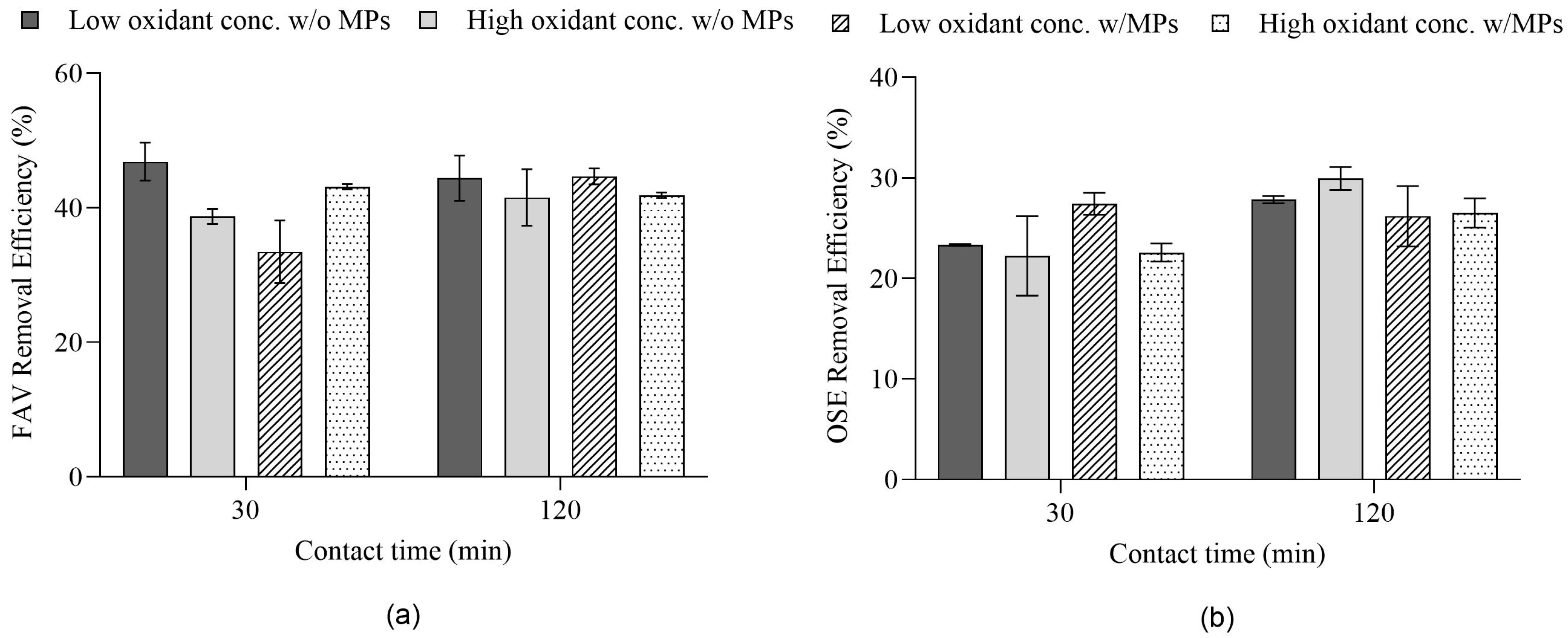
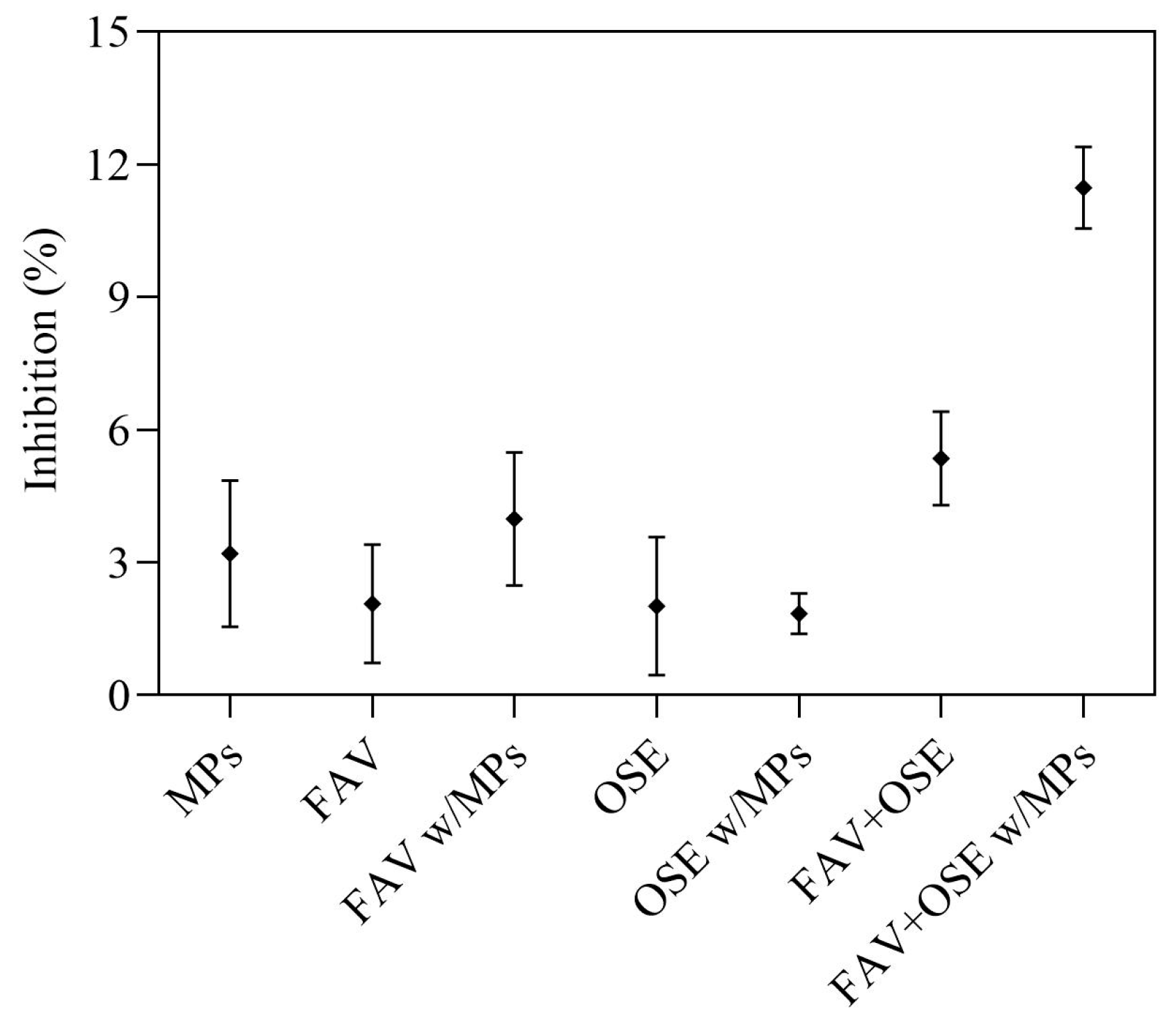
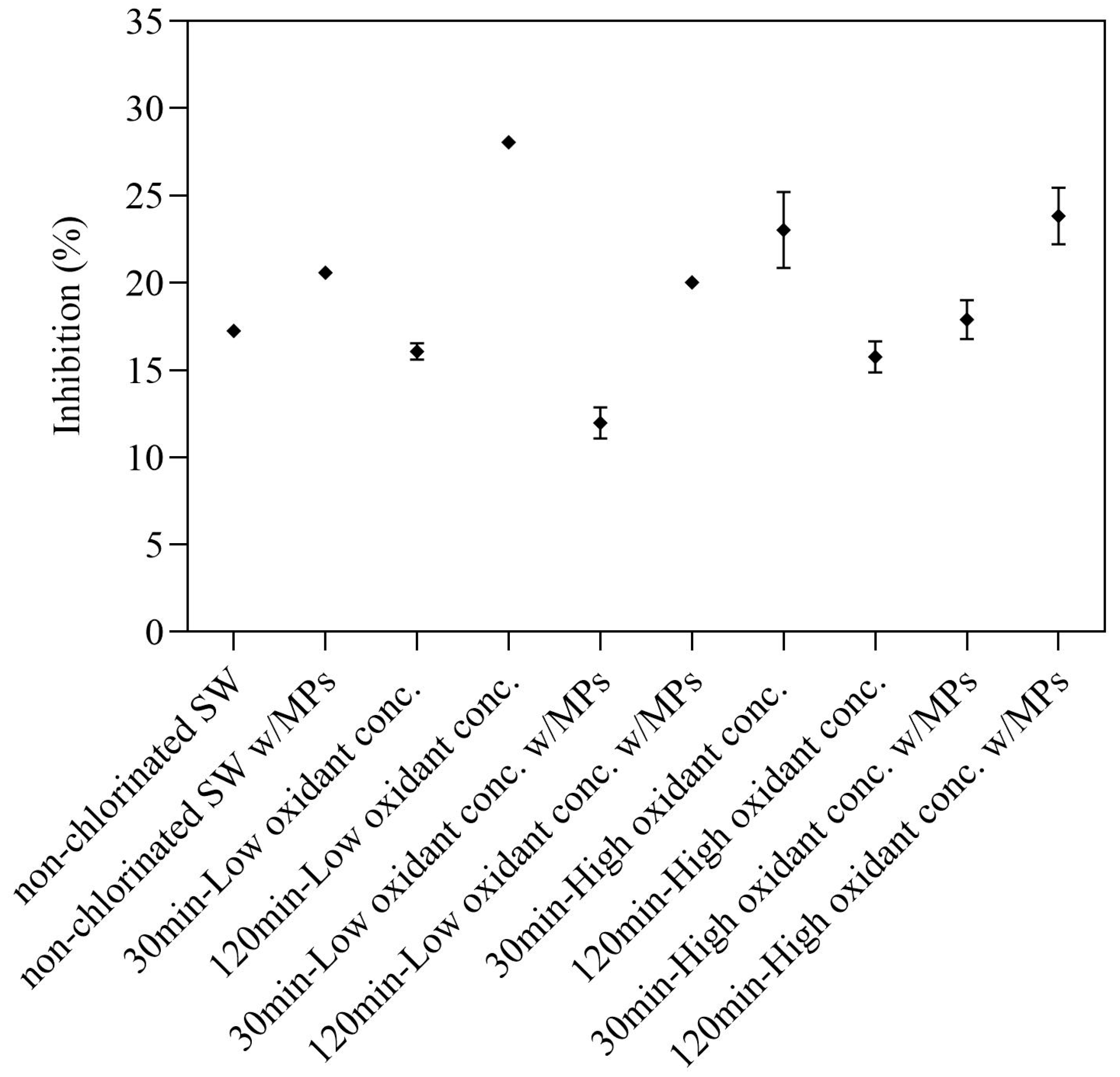
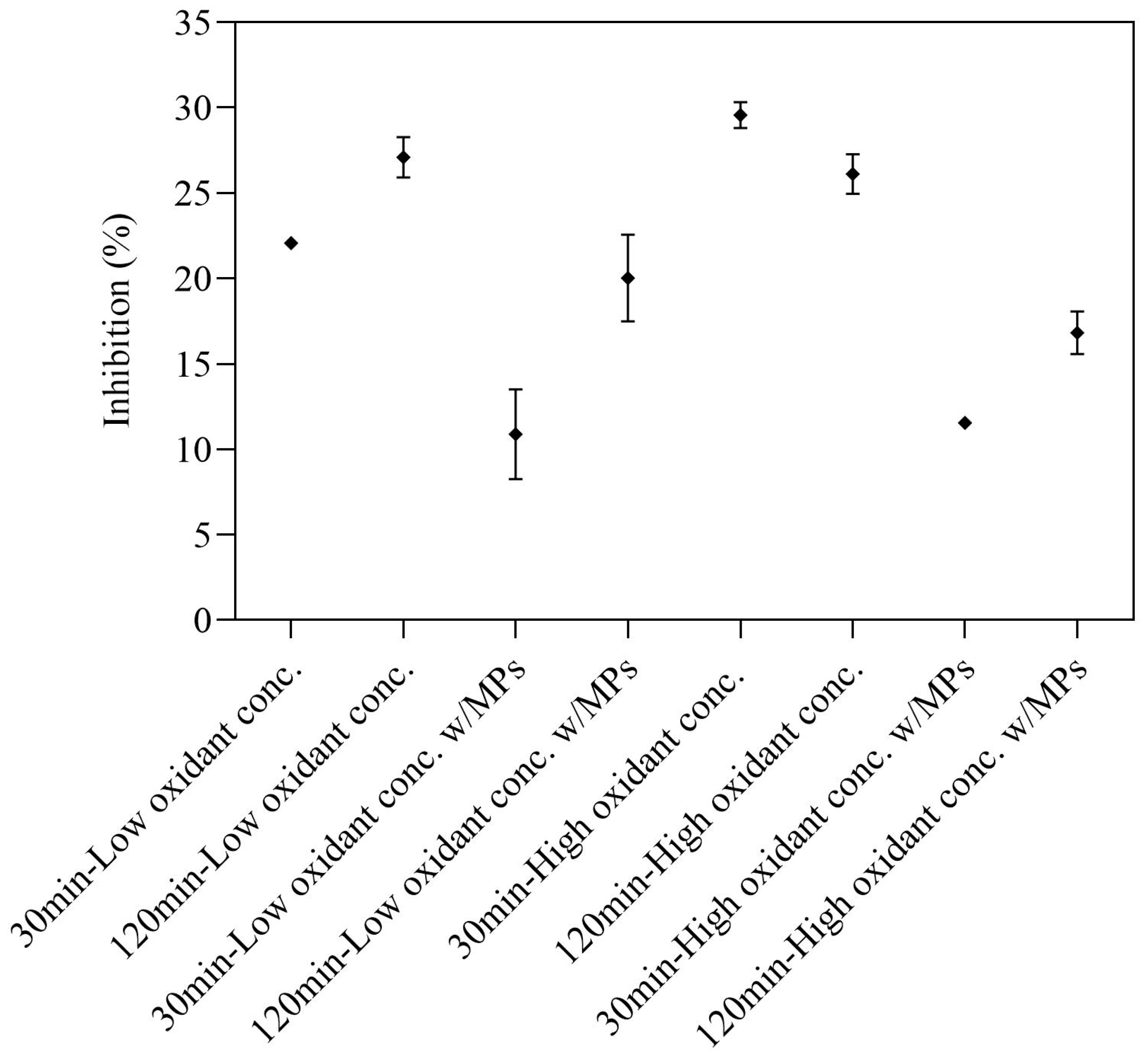
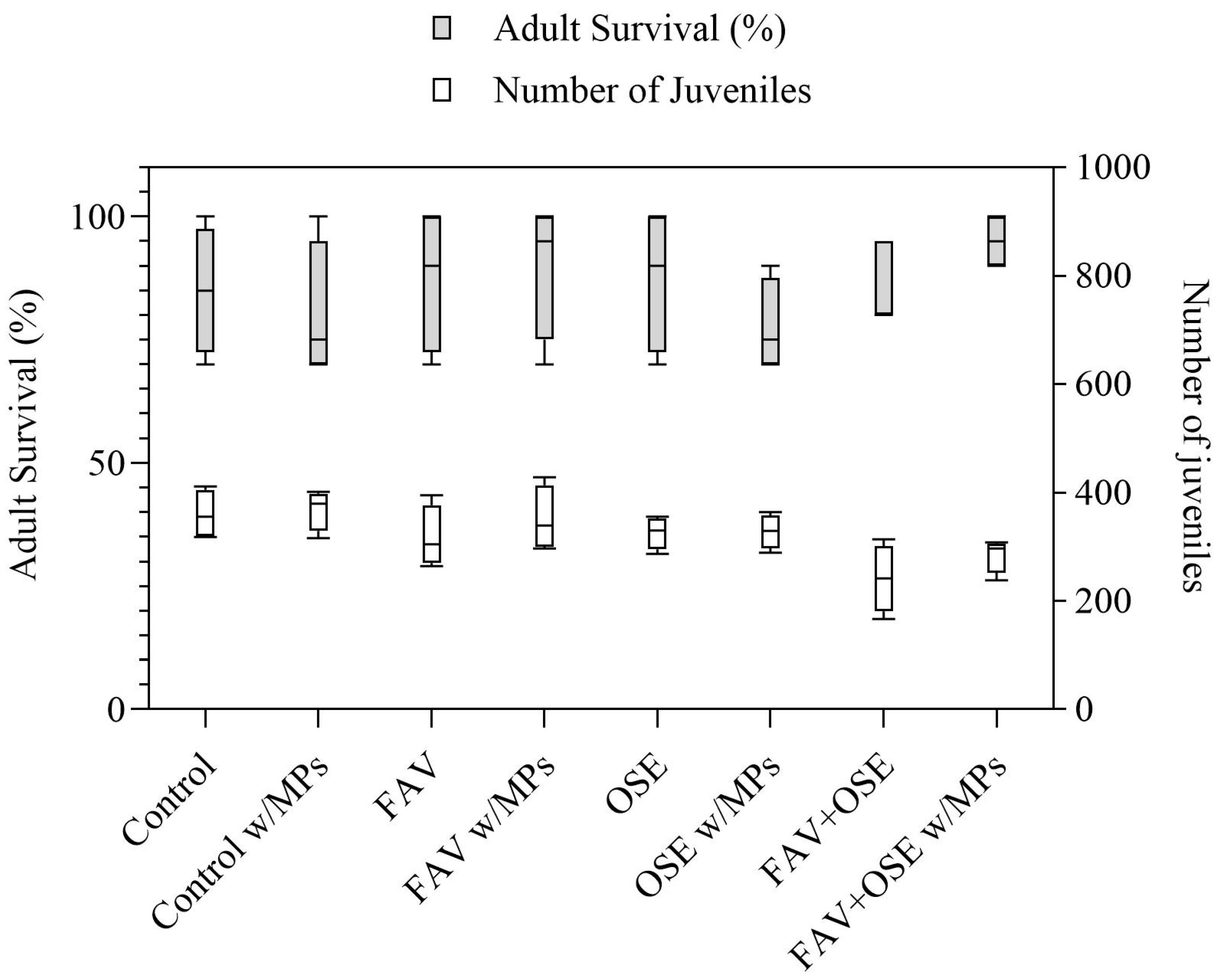

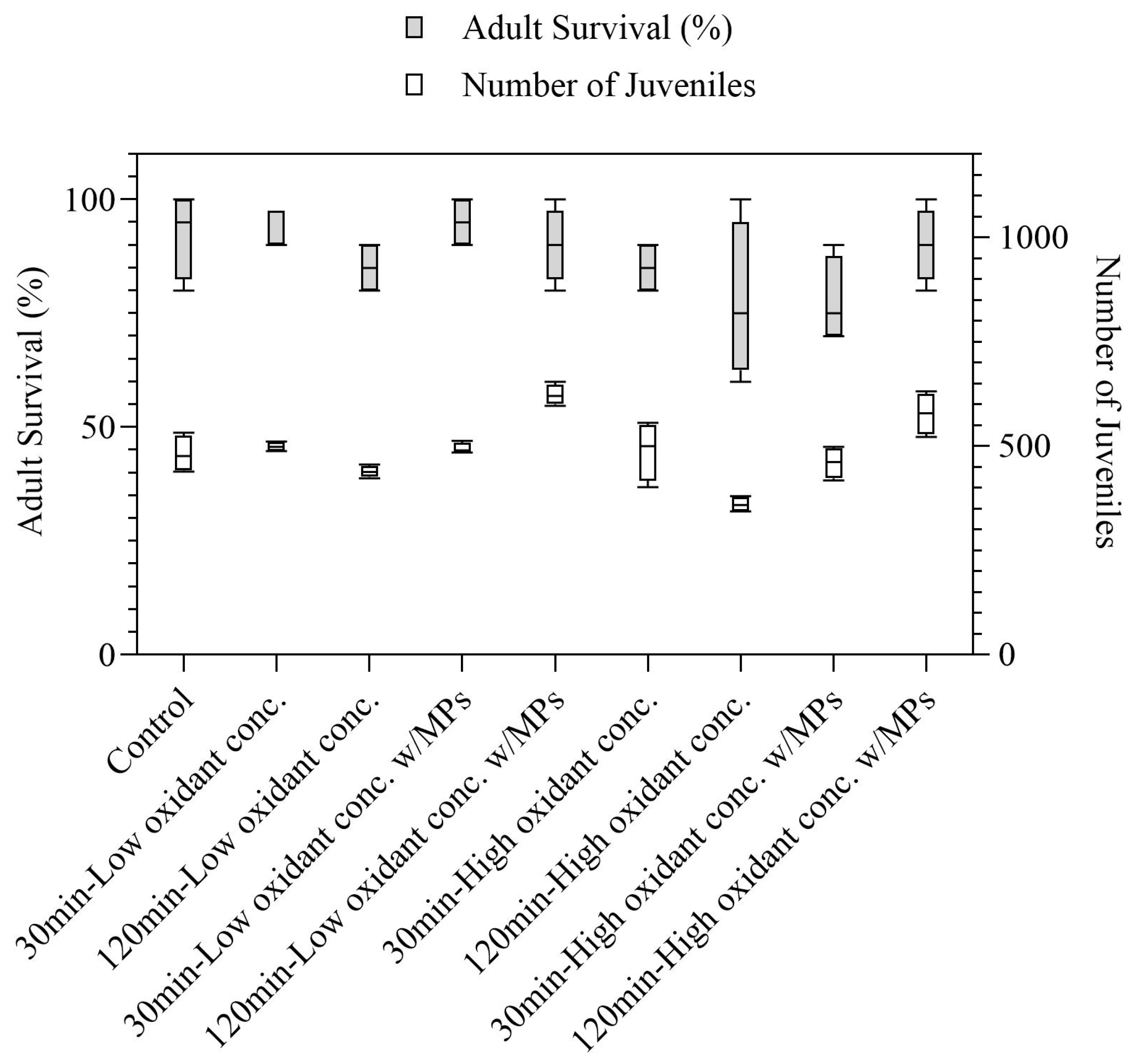
| COD(mg/L) | DOC(mg/L) | NH3-N(mg N/L) | NO2—N(mg N/L) | TP(mg P/L) |
|---|---|---|---|---|
| 47.5 ± 2.5 | 17.7 ± 0.9 | 0.75 ± 0.05 | 0.065 ± 0.005 | 1.9 ± 0.1 |
| Antivirals | Mother Ion (m/z) | Daughter Ions (m/z) | LOD (μg/L) | LOQ (μg/L) |
|---|---|---|---|---|
| Favipiravir | 158 | 84.97 112.988 141.042 | 5.2 | 5.8 |
| Oseltamivir | 313 | 166.071 208.125 225.196 | 1.5 | 2.5 |
| Isotopically labeled Favipiravir | 160 | 112.97 142.03 | ||
| Isotopically labeled Oseltamivir | 318 | 171.054 230.339 |
Disclaimer/Publisher’s Note: The statements, opinions and data contained in all publications are solely those of the individual author(s) and contributor(s) and not of MDPI and/or the editor(s). MDPI and/or the editor(s) disclaim responsibility for any injury to people or property resulting from any ideas, methods, instructions or products referred to in the content. |
© 2025 by the authors. Licensee MDPI, Basel, Switzerland. This article is an open access article distributed under the terms and conditions of the Creative Commons Attribution (CC BY) license (https://creativecommons.org/licenses/by/4.0/).
Share and Cite
Bilgin-Saritas, N.; Topuz, E.; Pehlivanoglu, E. Chlorination of Antivirals in Wastewater: Effects of Microplastics and Ecotoxicity on Aquatic and Terrestrial Species. Processes 2025, 13, 866. https://doi.org/10.3390/pr13030866
Bilgin-Saritas N, Topuz E, Pehlivanoglu E. Chlorination of Antivirals in Wastewater: Effects of Microplastics and Ecotoxicity on Aquatic and Terrestrial Species. Processes. 2025; 13(3):866. https://doi.org/10.3390/pr13030866
Chicago/Turabian StyleBilgin-Saritas, Nilay, Emel Topuz, and Elif Pehlivanoglu. 2025. "Chlorination of Antivirals in Wastewater: Effects of Microplastics and Ecotoxicity on Aquatic and Terrestrial Species" Processes 13, no. 3: 866. https://doi.org/10.3390/pr13030866
APA StyleBilgin-Saritas, N., Topuz, E., & Pehlivanoglu, E. (2025). Chlorination of Antivirals in Wastewater: Effects of Microplastics and Ecotoxicity on Aquatic and Terrestrial Species. Processes, 13(3), 866. https://doi.org/10.3390/pr13030866






